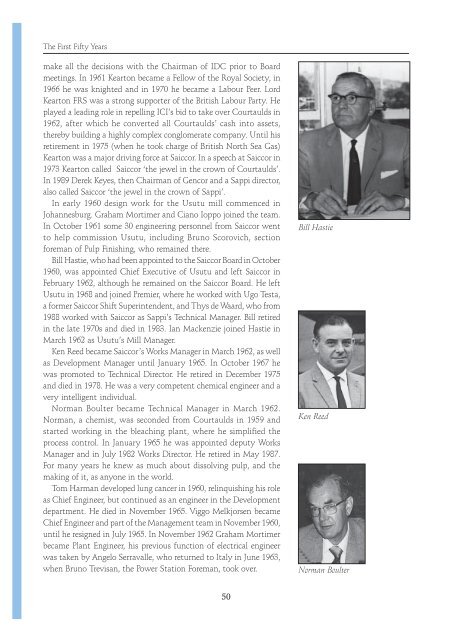You also want an ePaper? Increase the reach of your titles
YUMPU automatically turns print PDFs into web optimized ePapers that Google loves.
<strong>The</strong> <strong>First</strong> Fifty <strong>Years</strong><br />
make all the decisions with the Chairman of IDC prior to Board<br />
meetings� In 1961 Kearton became a Fellow of the Royal Society, in<br />
1966 he was knighted and in 1970 he became a Labour Peer� Lord<br />
Kearton FRS was a strong supporter of the British Labour Party� He<br />
played a leading role in repelling ICI’s bid to take over Courtaulds in<br />
1962, after which he converted all Courtaulds’ cash into assets,<br />
thereby building a highly complex conglomerate company� Until his<br />
retirement in 1975 (when he took charge of British North Sea Gas)<br />
Kearton was a major driving force at <strong>Saiccor</strong>� In a speech at <strong>Saiccor</strong> in<br />
1973 Kearton called <strong>Saiccor</strong> ‘the jewel in the crown of Courtaulds’�<br />
In 1989 Derek Keyes, then Chairman of Gencor and a <strong>Sappi</strong> director,<br />
also called <strong>Saiccor</strong> ‘the jewel in the crown of <strong>Sappi</strong>’�<br />
In early 1960 design work for the Usutu mill commenced in<br />
Johannesburg� Graham Mortimer and Ciano Ioppo joined the team�<br />
In October 1961 some 30 engineering personnel from <strong>Saiccor</strong> went<br />
to help commission Usutu, including Bruno Scorovich, section<br />
foreman of Pulp Finishing, who remained there�<br />
Bill Hastie, who had been appointed to the <strong>Saiccor</strong> Board in October<br />
1960, was appointed Chief Executive of Usutu and left <strong>Saiccor</strong> in<br />
February 1962, although he remained on the <strong>Saiccor</strong> Board� He left<br />
Usutu in 1968 and joined Premier, where he worked with Ugo Testa,<br />
a former <strong>Saiccor</strong> Shift Superintendent, and Thys de Waard, who from<br />
1988 worked with <strong>Saiccor</strong> as <strong>Sappi</strong>’s Technical Manager� Bill retired<br />
in the late 1970s and died in 1983� Ian Mackenzie joined Hastie in<br />
March 1962 as Usutu’s Mill Manager�<br />
Ken Reed became <strong>Saiccor</strong>’s Works Manager in March 1962, as well<br />
as Development Manager until January 1965� In October 1967 he<br />
was promoted to Technical Director� He retired in December 1975<br />
and died in 1978� He was a very competent chemical engineer and a<br />
very intelligent individual�<br />
Norman Boulter became Technical Manager in March 1962�<br />
Norman, a chemist, was seconded from Courtaulds in 1959 and<br />
started working in the bleaching plant, where he simplified the<br />
process control� In January 1965 he was appointed deputy Works<br />
Manager and in July 1982 Works Director� He retired in May 1987�<br />
For many years he knew as much about dissolving pulp, and the<br />
making of it, as anyone in the world�<br />
Tom Harman developed lung cancer in 1960, relinquishing his role<br />
as Chief Engineer, but continued as an engineer in the Development<br />
department� He died in November 1965� Viggo Melkjorsen became<br />
Chief Engineer and part of the Management team in November 1960,<br />
until he resigned in July 1965� In November 1962 Graham Mortimer<br />
became Plant Engineer, his previous function of electrical engineer<br />
was taken by Angelo Serravalle, who returned to Italy in June 1963,<br />
when Bruno Trevisan, the Power Station Foreman, took over�<br />
<strong>50</strong><br />
Bill Hastie<br />
Ken Reed<br />
Norman Boulter

















